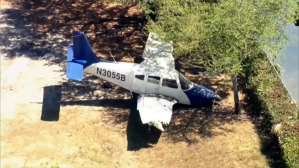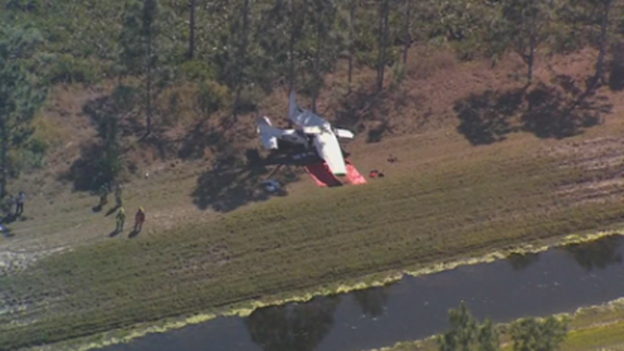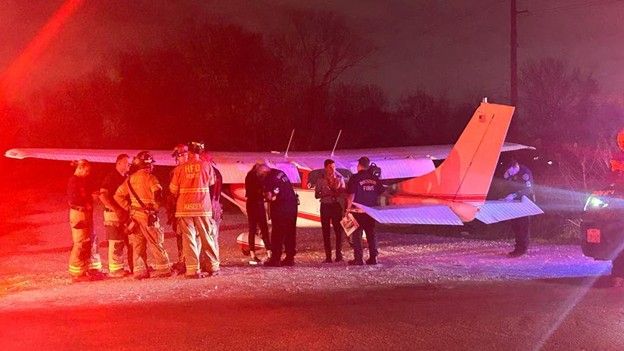ARFF Daily News
Published on:
Thursday the 13th of March, 2025
Small plane crash-lands near elementary school in Miramar; no injuries reported
By Nicole Linsalata, Kathleen Ditton, Kevin Boulandier, Alex Browning
MIRAMAR, FLA. (WSVN) - A small plane with two people on board made an emergency landing on a field next to an elementary school in Miramar, authorities said.
The Piper PA-28 came down near Coconut Palm Elementary School, located at 13601 Monarch Lakes Blvd., just after 1 p.m., Wednesday.
“Somewhere along the flight, they noticed that they had a problem with the engine. They looked for a place to land and safely managed to land [near] the school playground,” said Miramar Police Chief Delrish Moss.
Miramar Police confirmed that while the aircraft sustained some damage, there were no injuries reported.
The school did not sustain any damage.
The school was not placed on lockdown, and traffic flow in the area was not affected by the incident.
According to Flightradar24, the plane took off just before 1 p.m. from North Perry Airport. The pilot stayed close to the airport and then headed west before coming down on the field.
“We got engine failure. We are just gonna land somewhere here,” said the pilot.
“3055 Bravo. You said engine failure?” said the tower dispatcher.
“We got engine failure. 55 Bravo,” said the pilot.
“55 Bravo. Roger. You’re going to be able to make it to the field?” said the dispatcher.
“No I don’t think I’ll be able to make it to the field, just going to land right here,” said the pilot.
On its descend, the plane clipped a fence and skirted between two portables but didn’t touch neither of them.
Moments after it crash landed, another pilot flew overhead and reported back to the tower.
“I’m right over him. He’s just about two to three miles east of Interstate-75. They just landed here on a little forest here next to the houses,” said the other pilot.
Police said minutes before the plane landed, the portable was being used for school activities and there were children playing in the playground. Thankfully, everyone had gone back inside when the pilot landed.
This is not the first time this plane, owned by a company out of Delaware, has had to make an emergency landing. In 2022, the same plane made an emergency landing at North Perry Airport. No injuries were reported at that time either.
Area resident Santiago said it is a miracle that the landing did not cause any damage or injury.
“It’s a miracle, a miracle. He made a perfect landing. Had he gone further in there and the kids were playing, that would’ve been a catastrophe. That guy that flew that airplane deserves a medal,” he said.
Another neighbor said she is thankful everyone was OK.
“Wow, they were lucky and the school, the kids, oof. I know the parents were probably very worried,” said Miriam Zeno.
Police detectives stayed on the scene all day Wednesday. The Federal Aviation Administration is leading the investigation.
The FAA released a statement that reads:
“A Piper PA-28 crashed in a field shortly after taking off from North Perry Airport in Hollywood, Florida, around 1:05 p.m. local time on Wednesday, March 12. Two people were on board. The FAA will investigate.”
Parents said they received an email about what happened.
“I knew we were near dismissal time, so that was another concern. To see where did it hit, where did it land? Did it land in the building? Did it land on the field or what not?” said Luzmary Ocambo.
The National Transportation Safety Board is currently looking into the incident.
The plane is expected to be towed away on Thursday.

Small plane makes emergency landing in Orange County, officials say
By Chancelor Winn
ORLANDO, Fla. - A small plane made an emergency landing in the Wedgefield area of Orange County on Wednesday afternoon.
Residents describe chaotic scene to FOX 35
What we know:
A Cessna TU206G plane made an emergency landing in Orange County after experiencing engine failure shortly after takeoff. The pilot managed to land the aircraft along a canal between two neighborhoods near the Hal Scott Nature Preserve.
Nearby residents witnessed emergency responders arriving at the scene, with one wing of the plane visibly snapped and tangled in a tree.
The Federal Aviation Administration (FAA) lists the plane as registered to GPI Geospatial, a company based at Orlando Executive Airport. Both the FAA and the National Transportation Safety Board (NTSB) are investigating the incident.
What we don't know:
Investigators have yet to determine the exact cause of the engine failure. It is unclear whether mechanical issues, weather conditions, or other factors played a role in the emergency landing. GPI Geospatial, the plane’s registered owner, has not yet commented on the incident. Additionally, the condition of the pilot and any passengers remains unknown.
The backstory:
Emergency landings are rare but not unheard of, particularly with small aircraft. The area where the plane landed is near the Hal Scott Nature Preserve, which includes open land and waterways but is bordered by residential neighborhoods. Engine failure is one of the most common causes of small plane incidents, often requiring pilots to make quick decisions about landing sites to minimize damage and injury.
What they're saying:
Nearby residents described the chaotic scene as emergency crews rushed in.
"This has never happened before," said Bishop. "This is pretty unusual."
Exclusive video you can see one of the wings of the plane appears to be snapped. Now pointing upwards along a tree.
"We saw one emergency vehicle come down the back road. Well, we’ve seen that before and thought maybe a camper was in trouble or something and then another vehicle and another vehicle and then a parade of vehicles and then a helicopter," said Bishop. "So we knew something was up."
The National Transportation Safety Board says the Cessna TU206G plane had reported engine failure shortly after taking off, which forced the pilot to make an emergency landing along a canal between two neighborhoods near the Hal Scott Nature Preserve.
"There's a really small strip there and he was able to land on that small strip," said Bishop. "That's pretty amazing to me."
Other nearby residents like Christine Steele say they could see the wreckage from behind their homes."I can see a lot of different vehicles in the backyard," said Steele. "If you zoom in with binoculars, you can actually see the plane crash."
A plane making an emergency landing so close to Steele’s home has her family feeling a bit anxious about flying.
"My daughter and I are planning a trip to Las Vegas at the end of May, and she called me after hearing about this," said Steele. "She's really concerned about flying and not really wanting to go anymore."
What's next:
The FAA and NTSB will continue their investigation to determine the cause of the engine failure and assess any safety concerns. Authorities may release preliminary findings in the coming weeks, but full investigations into aviation incidents could take months.
https://www.fox35orlando.com/news/small-plane-makes-crash-landing-orange-county-officials-say

Plane makes safe emergency landing in east Houston
By Briahn Hawkins and Abigail Dye
The Brief
- A plane landed on Fidelity Street near Yuma Street.
- No injuries were reported.
- Two people were onboard.
- The plane allegedly suffered engine failure.
Plane landing on Fidelity Street
What we know:
Officials got a call about the plane at about 9 p.m. on Tuesday.
The plane landed safely on Fidelity Street near Yuma Street.
Officials say two people were onboard the plane, but neither of them were injured, and the plane remains intact.
The plane allegedly suffered an engine failure before conducting the emergency landing.
What we don't know:
FOX 26 is working to confirm if the plane was traveling to or from Hobby Airport.
https://www.fox26houston.com/news/plane-landing-east-houston

NTSB Prelim: Robinson Helicopter Company R44
Purpose Of The Flight Was To Perform A Low-Level Aerial Survey Of White-Tailed Deer
Location: Uvalde, TX Accident Number: CEN25FA104
Date & Time: February 27, 2025, 13:19 Local Registration: N144SG
Aircraft: Robinson Helicopter Company R44 Injuries: 2 Fatal
Flight Conducted Under: Part 91: General aviation - Aerial observation
On February 27, 2025, about 1319 central standard time, a Robinson Helicopter Company (RHC) R44 helicopter, N144SG, sustained substantial damage when it was involved in an accident near Uvalde, Texas. The commercial pilot and the passenger sustained fatal injuries. The helicopter was operated as a Title 14 Code of Federal Regulations Part 91 aerial survey flight.
According to the operator, the purpose of the flight was to perform a low-level aerial survey of white-tailed deer on the Two Sisters Ranch, Uvalde, Texas. The pilot was employed by the operator and the passenger worked for the Two Sisters Ranch performing wildlife management duties. The pilot had been employed by the operator for several years and had extensive experience performing low-level aerial surveys and was familiar with the operating area.
The aerial survey flights are typically flown between 75 to 100 ft above ground level, east to west passes are performed, and with an airspeed between 20 to 30 kts. As the deer are observed, the front left seat passenger would record his observations in a notebook noting the number of bucks, does, and yearlings. Also onboard the helicopter was a Benelli M2 12-gauge shotgun with buckshot shotshells, that would be utilized from the air to dispatch wild pigs (classified as an invasive species) that were observed on the ranch property.
The helicopter departed from the ranch about 0730 for the aerial survey work. The operator had a fuel truck staged at the ranch to facilitate fueling operations. The ranch foreman noticed that the helicopter was past due to refuel, and he contacted the wife of the pilot. The wife of the pilot had also received a Life360 emergency notification on her cellular phone about the accident, that had originated from the pilot’s cellular phone. First responders were notified about the missing helicopter, and the wreckage was located in a remote, flat area on the ranch, consisting of trees, brush, and cactus. The accident site, about 1,090 ft above mean sea level, was located about 245 ft to the east of a dirt road and a wildlife feed and water station.
The helicopter sustained substantial damage to the fuselage, the main rotor system, the tailcone, and the tail rotor system. The wreckage was recovered from the accident site, and it was transported to a secure location. During an onsite examination of the airframe, the upper clevis of the forward right hydraulic servo (part number D212-1 and serial number 36692) was found separated. The threads of the clevis were damaged, and fretting dust was present on the clevis, the associated hardware, and on top of the servo body. A small portion of green torque stripe paint was present above the palnut on the clevis. Three hydraulic servos (two forward and one aft) are located on the top deck of the helicopter.
A review of the airframe maintenance records showed that on November 10, 2023, at 3,254.7 hours, the two new forward hydraulic servos (ordered from the RHC) were installed by Heli Tech, LLC, Uvalde. The most recent airframe maintenance work was performed on January 24, 2025, a 100-hour inspection, at 4,019.12 hours, also by Heli Tech, LLC. The Datcon Hour Meter sustained impact damage, and the airframe time, at the time of the accident, was undetermined.
The helicopter, known as a Raven II, was equipped with Lycoming IO-540-AE1A5 reciprocating engine. The helicopter was not equipped with an emergency locator transmitter (commonly known as an ELT), nor was it required by regulation. The helicopter was equipped with a Garmin GDL 50 unit; however, a search revealed no Automatic Dependent Surveillance - Broadcast data for the accident flight.
A Garmin Aera 796 unit and the pilot’s Garmin D2 watch were transported to the NTSB Vehicle Recorders Laboratory. The three hydraulic servos were transported to the NTSB Materials Laboratory.
The operator was working under an Aerial Wildlife and Exotic Animal Management Permit M-73, issued by the Texas Parks & Wildlife Department, on January 16, 2025. The ranch owner had obtained a Landowner’s Authorization (LOA) to Manage Wildlife or Exotic Animals by Aircraft M-73-59530, issued by the Texas Parks & Wildlife Department, on February 25, 2025.
The operator, who is based in Uvalde, utilizes a fleet of RHC R22 and R44 series helicopters for their work across the country that also includes aerial capture, eradication, and tagging of animals (commonly known as ACETA).
FMI: www.ntsb.gov

Today in History
58 Years ago today: On 13 March 1967 South African Airways flight 406, a Vickers Viscount, crashed into the sea while on approach to East London Airport, South Africa, killing all 25 occupants.
Date: Monday 13 March 1967
Time: 17:10
Type: Vickers 818 Viscount
Owner/operator: South African Airways - SAA
Registration: ZS-CVA
MSN: 317
Year of manufacture: 1958
Engine model: Rolls-Royce Dart 525
Fatalities: Fatalities: 25 / Occupants: 25
Other fatalities: 0
Aircraft damage: Destroyed, written off
Category: Accident
Location: 2,4 km SE off Kayser's Beach - South Africa
Phase: Approach
Nature: Passenger - Scheduled
Departure airport: Port Elizabeth Airport (PLZ/FAPE)
Destination airport: East London Airport (ELS/FAEL)
Investigating agency: SA BoI
Confidence Rating: Accident investigation report completed and information captured
Narrative:
South African Airways flight 406, a Vickers Viscount, crashed into the sea while on approach to East London Airport, South Africa, killing all 25 occupants.
Vickers Viscount ZS-CVA, named "Rietbok", was on a scheduled public transport flight SA406 from Port Elizabeth to Johannesburg via East London and Bloemfontein, South Africa.
At Port Elizabeth crew took on board 2,000 lb of fuel in excess of the normal sector fuel uplift, on the basis that they may had to overfly East London and proceed to Bloemfontein due to poor weather at East London.
The flight made a normal takeoff from Port Elizabeth at 16:41 UTC and climbed to Flight Level 90. At 16:58 UTC the aircraft contacted East London Airport Control and was given a weather report: 8/8ths Nimbo Stratus at 200 feet to 300 feet overhead, lowering on the approaches to runway 28; continuous drizzle; visibility 3/4 of a mile; ground temperature plus 16°C.; QNH 1025.
At 16:59 UTC the aircraft acknowledged the weather and requested descent clearance from Flight Level 90. Clearance was given by East London Tower and acknowledged.
At 17:07 UTC the flight was cleared for a runway 10 approach. The last radio transmission was at 17:09 UTC when the flight reported at 2000 feet with the coast line in sight. The airplane impacted the sea at high speed about 17:10 UTC.
Bits of floating wreckage, consisting mainly of cabin interior fittings, were recovered by naval vessels and other pieces were washed ashore.
The main wreckage of the aircraft is believed to he lying at a depth of between 180 and 220 feet, approximately 1½ miles off-shore. Extensive salvage operations were attempted, but were hindered by murky water, a current up to 8 kts. and dangerous sea conditions.
PROBABLE CAUSE: "The available data is not sufficient for the originating cause of the accident to be determined with any degree of probability. In the opinion of the Board certain possibilities can be excluded as being consistent with the evidence and/or as being remote and improbable; among these possibilities are structural failure, failure of the controls, or control surfaces, multiple engine failure, instrument failure, explosion, fire, a 'bad weather' accident and pilot error.
However, on the evidence the Board cannot exclude as the originating cause of the accident a heart attack suffered by the captain in the air, with ensuing loss of control of the aircraft, and with the first officer being unable in the time available to regain sufficient control to prevent contact with the sea."
It was later rumored that the aircraft crashed as a result of a structural failure, because comparable accidents happened during that time.

